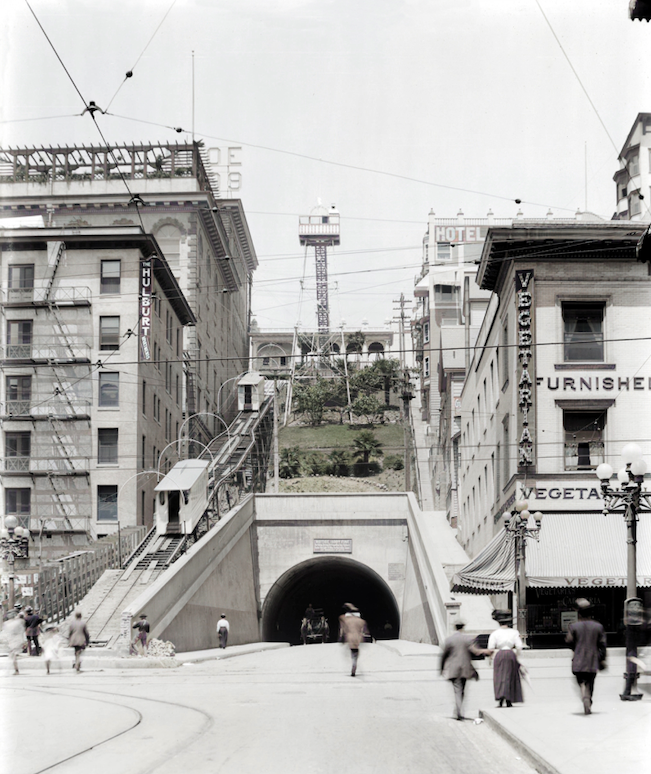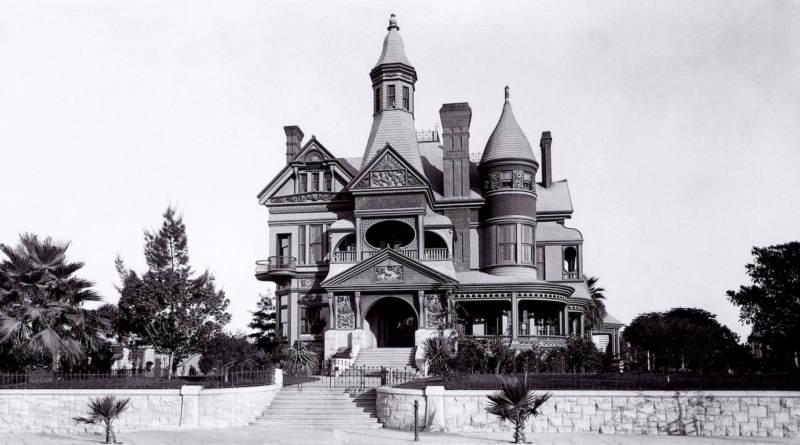INTERVIEW: In his new book, Nathan Marsak travels to the heart of Bunker Hill, Los Angeles
Photo: The Lewis Leonard Bradbury mansion, at the corner of Court and Hill streets, was designed by Samuel and Joseph Cather Newsom and completed in 1887. It was demolished for a parking lot in 1929. Photo courtesy of Nathan Marsak / Provided with permission.
Walking in Downton Los Angeles today can be an enjoyable, if somewhat chaotic experience. High-rise skyscrapers cast long shadows on the streets below. Cultural institutions, like The Broad, Museum of Contemporary Art and Walt Disney Concert Hall, shake up the landscape with unique architectural buildings. Los Angeles City Hall stands sentinel, while routes 10, 110 and 101 support legions of vehicles careening down the pavement, traveling around the boundaries of this historic neighborhood.
Within the footprint of Downtown there used to be a section of the city separated from all other areas, a neighborhood that featured Queen Anne mansions, with some Beaux-Arts and Mission Revival thrown in for good measure. It was a place of gargantuan hotels, like the Fremont, the New Northern and the Belmont, and killer views across the cityscape and the streets below. Yes, there was even a funicular, or incline railway, that took tired locals from the bottom of the neighborhood to the top.
This was Bunker Hill, Los Angeles.
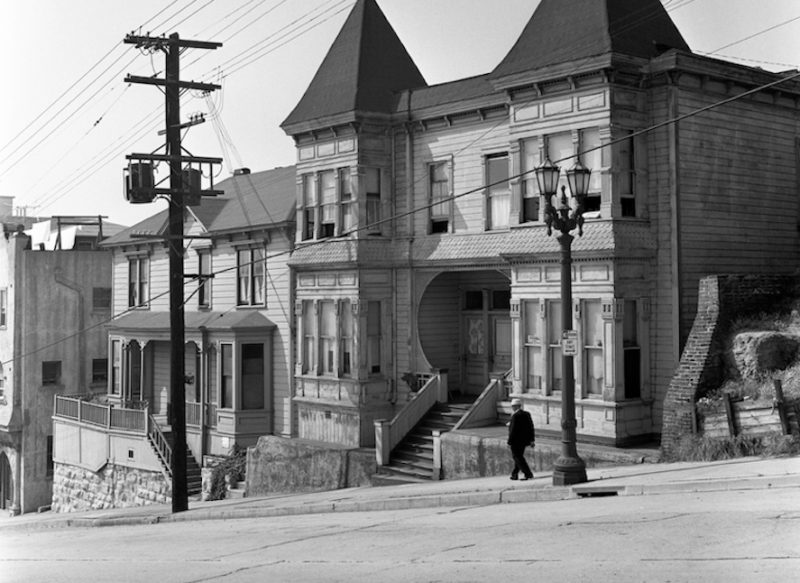
Nathan Marsak, a native of Santa Barbara, California, who now lives in Los Angeles, has been enamored with this neighborhood for decades. Its mystique and mystery won him over for a number of reasons, but there’s one dominant justification for his fascination: Bunker Hill is no more. This historic city-within-a-city was razed and redeveloped in the second half of the 20th century, its residents relocated and its Queen Anne architecture torn down. A walk through Downtown today offers passersby the faintest recollection of what the area must have been like at the end of the 19th century and into the 20th century. There’s still Angels Flight, the funicular ride, which is in a new location, and there’s also a foundation of one building that can be viewed. That’s it … well, maybe. More on that in a bit.
Marsak, admiringly obsessed with this lost-but-not-forgotten neighborhood, decided to put his love for Bunker Hill into print and send some of these stories to the masses. First, he wrote and researched with Kim Cooper, a fellow history buff, for the On Bunker Hill blog, and this past year he celebrated the publication of his new coffee table book remembering the neighborhood and its history. Bunker Hill Los Angeles: Essence of Sunshine and Noir is now available from Angel City Press and features a foreword by Gordon Pattison, who used to live on Bunker Hill.
These pages feature historical passages about the neighborhood, archival photographs of what the streets and buildings looked like, unique stories about some of the residents, and information about Hollywood’s noir-ish love of Bunker Hill. The cover image features Angels Flight in mid-flight, descending on its raised railway, while a man with a white shirt, white hat and black suspenders walks in front of orange barrels with “City of L.A.” stamped on the side. He’s holding a folded newspaper, and his shaded face is looking almost right into the lens of the camera. He was walking on Bunker Hill’s soon-to-be-gone landscape, a man on borrowed time strolling amongst remnants of a lost Los Angeles.
For Marsak, there were so many stories of this section of the city — too many stories, in fact. He needed to have some of the more salacious and scandalous content (crimes and such) spill over into a zine called Bunker Noir! True Crime on Los Angeles’s Bunker Hill, a softcover book that promises stories of cocaine and hacksaws, Lizard Men, and honeymoon horrors.
“I was compiling the Bunker Hill book for Angel City Press, and that’s more of a general history / coffee table book,” Marsak said in a phone interview earlier this year. “So it’s very big and lavish, but also is a large history. The editor came back and said, ‘I appreciate your enthusiasm and your zeal for this one element of the tale, but what’s with all this noir and death and horror? It’s a little bit of a grim slog through this litany of suicide and murder.’ I’m like, ‘But it’s such an important tale.'”
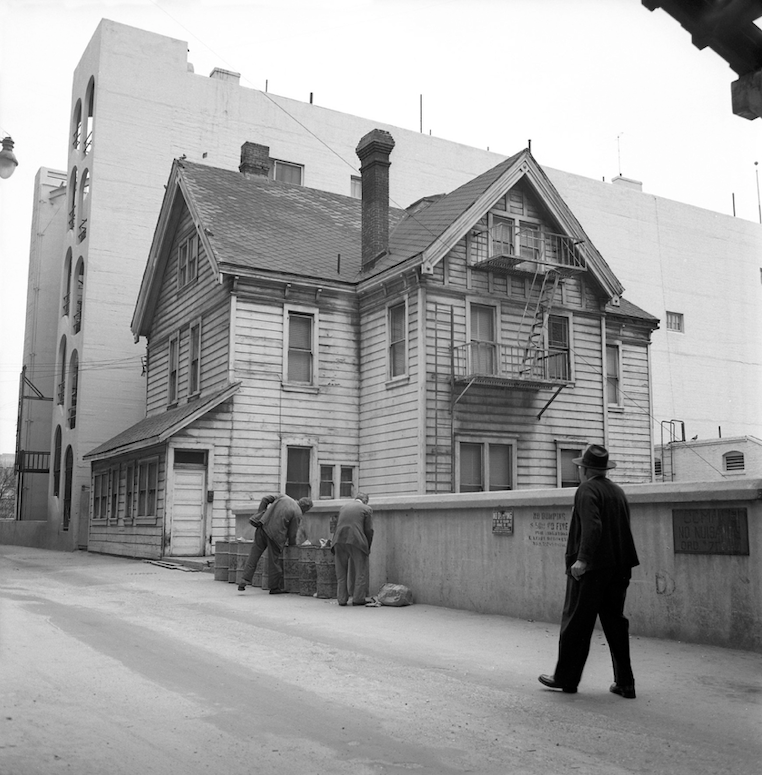
Marsak knows what he’s talking about. When he started working seriously on his Bunker Hill research back in 2008 — with his friend, Kim Cooper, on the On Bunker Hill blog — he learned about the many true-crime stories that happened on the hill, and he wanted somehow to include them in his book project.
“We come from an old zine culture, if you’re familiar with the days of going to Kinko’s at 2 in the morning and Xeroxing some weird zine about your favorite bridge mix and then sending three copies of it to somebody in Kentucky because they think your zine is cool,” he said. “So [Cooper] said, ‘You should make a zine about the noir things that happened on Bunker Hill because you’ve got all these old photos that no one has ever seen before, and you’ve got all this old history that no one has ever read before.’ And I don’t tend to do things halfway or half-assed, so the concept of a zine became a 56-page quality printed throwback to the crime mags of yore, Bunker Noir!”
For those keeping score at home, one can jump on this reminiscing train with Marsak in several ways: the flagship is the new book, Bunker Hill Los Angeles; the zine is Bunker Noir!, which has been printed in a limited edition; and the early days were blog entries on the website On Bunker Hill. Each of these projects — and no doubt there will be more in the future — are thanks to Marsak’s years of researching.
“I’ve been collecting for many, many years,” the author said. “Photos in some respect come from the usual suspects, the archives of the Huntington Library, UCLA, USC, California State Library, certainly LAPL, the Los Angeles Public Library, and I know all the research librarians and image archivists therein. But as someone who also knows the other weirdos like me, the collectors, we buy and sell and trade.”
Over the years, Marsak has purchased archival press photographs, and he knew the niece of famed photographer Arnold Hylen, whose two L.A.-centered books are Los Angeles Before the Freeways and Bunker Hill — A Los Angeles Landmark. These came out in the late 1970s and early 1980s, and Marsak now has those archives and plans to reissue Hylen’s books at some point.
“Most of [the images] are things that I found in my own binders,” Marsak said. “I’ve got something like 10 clamshell binders full of negatives and photographs and postcards and things like that that I’ve been collecting — press photographs, amateur photographs, police photography that I’ve been collecting for 20 years.”
Those clamshell binders, which must be a dream to lay out on the floor and pore through for hours on end, feature Los Angeles in general and Bunker Hill in particular. Marsak said his collection is a 50-50 split between the city as a whole and the city-within-a-city known as Bunker Hill.
“I don’t know why I like Downtown so much, but I certainly have a fairly good selection of stuff a little further afield,” Marsak said. “I’ve got some decent stuff that’s Westside. As someone who moved to Los Angeles and the first place he landed was gritty East Hollywood, anything sort of west of Western has never been my interest. I understand some people really love it. I get over there, and I’m sort of lost.”
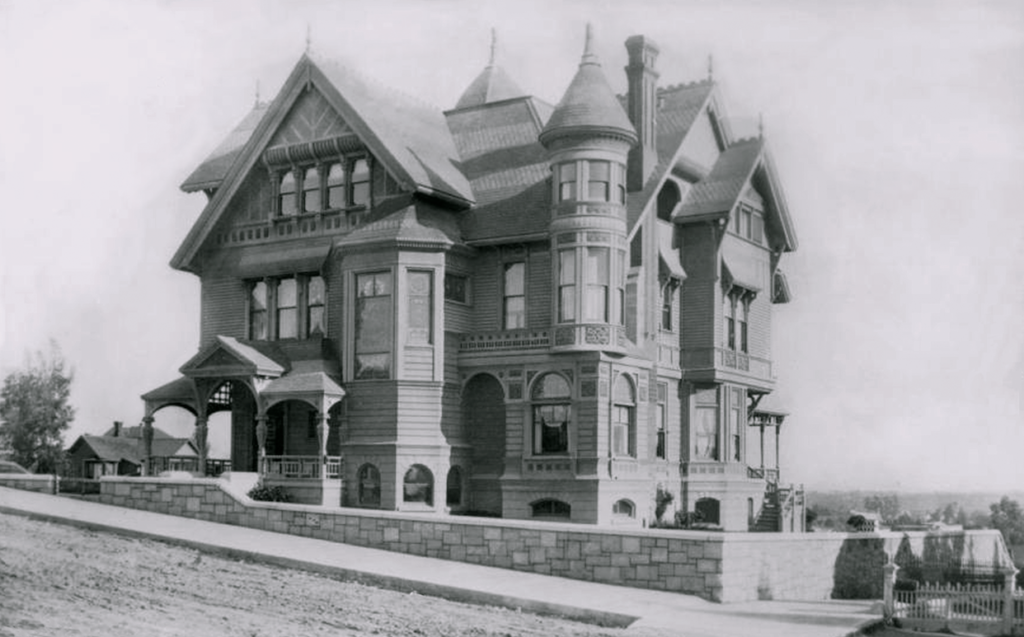
His fascination with Bunker Hill mostly comes from the neighborhood being a mysterious and lost world, as he put it. He said he started to appreciate these old Queen Anne buildings, which dominated the Victorian landscape, when he was only 7 years old, a child growing up in Santa Barbara and watching The Munsters on television.
“They lived at 1313 Mockingbird Lane,” he remembers. “I was totally obsessed with The Munsters, and I loved their house. I lived in a house that was not totally dissimilar. Our house may have been a little more Addams Family than Munsters, but I had a very strange family with a big old tumbledown house.”
He found The Munsters TV show “very L.A.” This city, connected to his Santa Barbara home by a relatively short stretch of highway, called for him in many ways. Besides The Munsters, he used to watch Los Angeles news programs and appreciate the Pete Ellis Dodge commercials and Zachary All Clothing advertisements.
“They were mythic to me, and Herman Munster tried out for the Dodgers,” he said, rattling off his younger obsession with Los Angeles. “There was surf music, and there were Beatniks and stuff like that. I thought L.A. was this big, weird, creepy place, and when I finally went to L.A., there were still little pockets of it, especially like Crown Hill, which is just the other side of what was then Bunker Hill. … Crown Hill still had tumbledown houses. That’s all gone now. So I developed sort of a fetish for weird, old, decaying Los Angeles.”
The movies about old L.A., and specifically Bunker Hill, entranced him as well. He watched and rewatched Criss Cross, Act of Violence, Cry Danger and Kiss Me Deadly, films that are now streamable and broadcast on TCM, but back when Marsak was growing up, he would head to old revival houses to see the film noir of yesteryear.
He said: “And you’d see Angels Flight going back and forth, and say to yourself, ‘Where the hell is that? I’m going to go there.’ And then you find out, oh, that’s gone. It being gone, you become obsessed. Like, well, now I’m going to go find out where it was.”
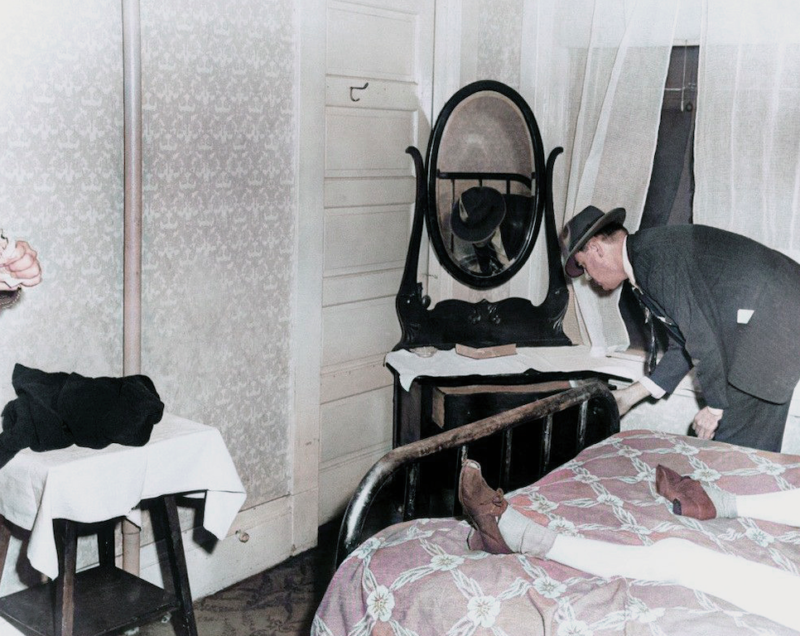
He remembers his first trip to Los Angeles, which was back in 1977. He was headed into the city to see his boyhood idol, Groucho Marx. He met the comedian at the Wilshire Hyatt House, and then his family had lunch at the famous Brown Derby. The next time he traveled to Los Angeles, Marx was dead, and the Brown Derby had been demolished. He quickly learned that Los Angeles, the vast place of his dreams, was not permanent. Change occurred on a daily basis, and historic preservation wasn’t always the rule of the day.
“And the concept of a big, rotting nest of Victorians sort of naturally spoke to me,” Marsak said. “I think other people get involved in Los Angeles because they think it’s this interesting 1960s ‘Jet Age’ futuristic place, and they have sort of a fetish for the Googie elements. Nowadays people harken back and fetishize 1970s Jackson Brown canyon culture, or they really like the 1980s New Wave. Having lived through the 1980s New Wave thing on Melrose Avenue, I never thought that would become retro or hip or whatever.”
Marsak kept researching and tried to understand why these historic buildings were razed and what ultimately happened to Bunker Hill. The book answers these queries, but ultimately it comes down to community redevelopment efforts and the perceived view that these decaying houses and hotels were “low brow.”
“They saw it as nefariously depraved,” Marsak said. “It was full of grifters and slatterns and hopheads, and, you know, I got into Bunker Hill around the same time I was a kid. And I was reading [William S.] Burroughs the way us young people do and listening to [John] Coltrane. I was thinking, oh my God, grifters and hopheads and slatterns — awesome. But that’s where it gets interesting because as much as I love the noir element of Bunker Hill, I began to investigate it further and actually talking to people that had lived up on the hill and actually began to collect the red-bordered Kodachromes of old Bunker Hill. What I discovered flew in the face of the conventional narrative of Bunker Hill in that everything I’d been taught was … from the L.A. Times, [and] the L.A. Times had a very particular slant. They were pro-redevelopment. They were echoing what the Community Redevelopment Agency was saying. These houses were beyond reclamation, and it was peopled by moral turpitude, etc. etc. But then once I got to talking to people who had lived there, and once I got to looking at color images, which nobody had seen, [I realized] Bunker Hill was an aged neighborhood as its people who populated it were mostly aged. They were pensioners, a word you don’t hear much anymore. They were the elderly urban poor, but as an aged neighborhood, it was comfortable. It was a little rundown naturally because there had been this threat of condemnation for so many years. It was a renter’s paradise up there on Bunker Hill. … Bunker Hill was kind of a pleasant, sun-lit, functioning neighborhood.”
Marsak added: “It was what we now engineer into our neighborhoods. It was green. It was adaptive reuse. It was walkable. It was mixed-used because it was people living above shops. It was low car ownership. It was that new urbanist paradise back in the day. … It was anachronistic to the Jet Age time of the 1950s and ’60s when you were supposed to drive to a massive parking lot to go do your shopping out in the suburbs.”
Bunker Hill continues to inspire Marsak to research, write and collect. He routinely checks out his trusted spots for photographs and archival information — all so he can complete this picture of a lost neighborhood that is nowhere to be seen but in the history books.
Well, almost nowhere to be seen …
This year, a few months after Marsak released his book and zine, something simply remarkable happened. As he tells it in Bunker Hill Los Angeles, it was believed until recently that there are no real remnants of Bunker Hill left. Yes, an updated Angels Flight still operates, but it’s in a different location. Yes, there’s a foundation of a building that passerby can see, but the Queen Anne architecture? Gone. The multi-story, many-roomed hotels? Gone. The estates and mansions? Gone.
But … the hospital? Not gone.
“I found a survivor,” Marsak said, almost as if he were a child again, watching the Munsters head into 1313 Mockingbird Lane.
There was a hospital in Bunker Hill that was built in 1885 and first located at 215 South Olive St. It didn’t look like a hospital compared to today’s medical centers. The building looked like a house, and its location on Olive Street between Second and Third streets put it squarely within Bunker Hill. Marsak described the structure as a wonderful “Eastlake-style” house, which is another subset of Victorian architecture. The building was eventually moved to Toluca Street in 1905 and then later moved once again to the Angeleno Heights District.
There, on the other side of the 101, not far from Echo Park and Elysian Park, sits what is believed to be the last remaining structure of Bunker Hill. Thanks to a friend who first made the discovery, Marsak has made contact with the current owner and was able to visit and photograph the building.
One of the proudest moments of his multi-year project is this simple statement: “So there is in fact one survivor of Bunker Hill.”
By John Soltes / Publisher / John@HollywoodSoapbox.com
Bunker Hill Los Angeles by Nathan Marsak is now available from Angel City Press. Bunker Noir! is also available as a limited edition zine. Click here for more information. All photographs and captions supplied by Nathan Marsak.
